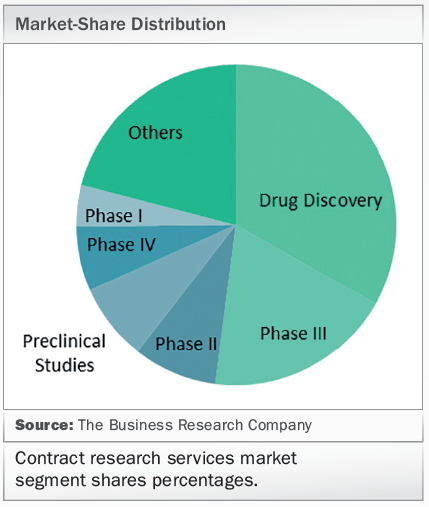CROs To See 12% Yearly Growth to 2021
The Business Research Company publishes a report that the global market for clinical trial services to biopharmaceutical and medical device companies is forecast to grow at 12% year-on-year to 2021.
The global market for clinical trial services to biopharmaceutical and medical device companies is forecast to grow at 12% year-on-year to 2021, a report from The Business Research Company shows. That is an acceleration from its rate of 10% up to 2017, which raised its value to $44.4 billion.
Contract research organizations (CROs) are defined as service providers that offer solutions for the conduct of clinical trials, including initial drug discovery solutions, toxicology studies, bioanalytical services, central laboratory functions, site monitoring, data management services, vigilance, biostatistics, study and development program design and consulting, regulatory affairs, and a variety of post-marketing surveillance services.

By service type, drug discovery was the largest segment in 2017, accounting for about 33% of the CRO market (see chart). By therapeutic area, oncology was the largest segment, accounting for about 25% of the total.
North America is the largest region for the production of CRO services, $18.8 billion, while CRO consumption in North America is worth $20.8 billion or about 47% of the global total. The large market size can be attributed to the presence of a large number of pharmaceutical companies and extensive drug development activity in the region, especially in the U.S. The production/consumption difference is due to the use of lower-cost offshore locations for some CRO activities by U.S. pharmaceutical firms, although the majority of U.S. outsourced activity remains within the country.
Declining growth in the pharmaceutical market is affecting the CRO industry, though not in the obvious way. Recently, the double-digit growth rates of pharmaceutical and biotechnology companies have been shrinking to single digits. Pharma and biotech companies have been confronted with the need to minimize their drug production and development costs. This has forced most of them to evaluate cost-saving options such as outsourcing. Several companies in this sector have already adopted this strategy and outsourced their processes to specialist service providers such as CROs.
IQVIA is the largest player in the global CRO market with a 12.4% share, followed by Laboratory Corporation of America Holdings, ICON Plc, PAREXEL, and PPD.
Metabolic disease segment on rise
The largest segment of the $44 billion contract research market is for clinical studies to develop therapies for cancer, but the smaller metabolic disease segment is growing much faster, the Business Research Company report shows.

Unifying Industry to Better Understand GCP Guidance
May 7th 2025In this episode of the Applied Clinical Trials Podcast, David Nickerson, head of clinical quality management at EMD Serono; and Arlene Lee, director of product management, data quality & risk management solutions at Medidata, discuss the newest ICH E6(R3) GCP guidelines as well as how TransCelerate and ACRO have partnered to help stakeholders better acclimate to these guidelines.
Phase III PROMINENT Trial Initiated to Evaluate Felzartamab for Primary Membranous Nephropathy
June 30th 2025The global Phase III PROMINENT trial has begun dosing patients to evaluate felzartamab in treating primary membranous nephropathy, a serious autoimmune kidney disorder with no FDA-approved therapies.
Funding Cuts Threaten Diversity in Clinical Research
June 27th 2025In this video interview, Kyle McAllister, co-founder, CEO, Trially, discusses how recent federal funding cuts are likely to undermine research focused on underrepresented populations, and why long-term investment in community-based studies is essential to closing persistent health equity gaps.